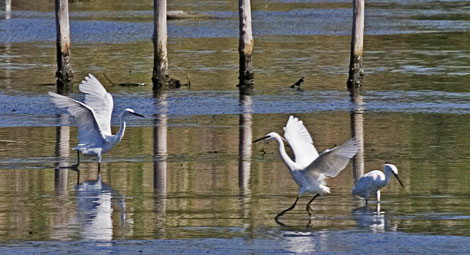 Airport lagoon |
|
Due to the Corfiots love of hunting most species of birds on the island shun human contact and might not be as abundant as in other parts of Europe therefore you have to work hard to observe them. In excess of 150 separate species have been catalogued on Corfu, some as migrants, and some quite rare. Certain species however are plentiful, whether this is because of their unsuitability for the pot or superstition is unknown. Throughout the island there are various habitat types, all within easy driving distance of each other. Just to whet your appetite some of those sites include: |
|
 Lefkimmi |
Lefkimmi Salt Pans: - Now disused and returning to nature. This is quite a large area and provides an undisturbed breeding ground for a number of species including waterfowl, Shorebirds, warblers Pipits etc. If you were really lucky you might spot Flamingo’s, a flock was seen in summer 2006, flying offshore only to divert to the saltwater marsh near Igoumenitsa on the mainland. During the hottest summer months much of this area resembles a desert landscape and it is easy to imagine it in its original working state. Therefore early spring and autumn would undoubtedly be the best time to visit. The surrounding reed beds, ditches and saltwater marsh/lagoon harbour most of the wildlife. |
| Ropa Valley: - this is the remains of a long dried out lagoon and spring would be the best time of the year to make a visit here. If you are lucky you can see quite a variety of species due to the fertility of the land and the changing terrain surrounding it. Rivers, streams and drainage ditches, many abundant in wildlife, crisscross the valley. |
|
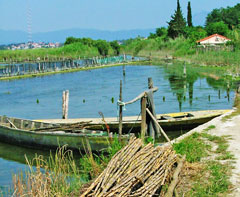 Halikiopoulos |
Airport Lagoon: - ( Lake Halikiopoulos) Unusual in its closeness to the airport, your plane will land on what is reclaimed land on the lagoon. There are almost always a number of Little Egrets, Grey Herons and sometimes the Great white heron, Cormorants and possibly Pygmy Cormorants, Terns and Marsh Harrier to name but a few. Note: EU funding has been secured to provide a nature trail and bird watching facilities on the lagoon. (2004)?
|
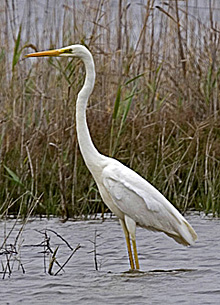 Great White heron |
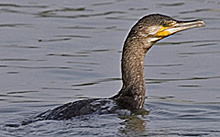 Cormorant Now 2008 and have not seen any activity on this project. Although the presence of the airport and safety regulations may have a bearing on this. Aircraft have been damaged by bird strike in the recent past. |
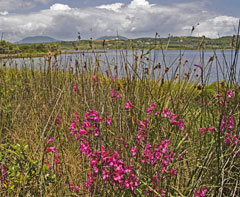 Korission |
Lake Korission: - on the south west of Corfu Lake Korission is separated from the sea by a strip of sand dunes, this area is relatively untouched by human activity. Egrets, Gulls, Waterfowl, Harriers, Kingfishers, Warblers, Hoopoe and a great variety of migrants can be sighted here during the spring and autumn migration. The Eastern shoreline is quieter, has more vegetation and probably the best place to sight birds. |
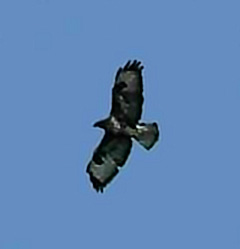 Buzzard |
Pantokrator Mountain: - Because Pantocrator is the highest peak on Corfu on a clear day (most days) the whole island is visible from the summit as are the Albanian and mainland Greek coastlines. Bird life although sparse is quite interesting and varied. Eagles, Kites and Buzzards patrol the skies while Falcons and Kestrels can also be seen pursuing their quarry. Blue Rock Thrush, Black Redstarts and Cirl Buntings are regularly seen here and obviously the lower foothills have a greater variety of species. |
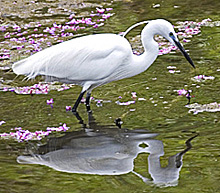 Little egret on Messongi river |
Major river valleys: - The main rivers such as the Messongi, Potamos and Ropa etc. don't always dry up completely during the intense summer heat and consequently they become an oasis for all wildlife during the mid summer months. Find yourself a nice shaded and secluded spot away from human activity, sit down quietly for half an hour and you are guaranteed to see something interesting. |
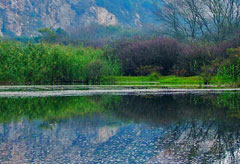 Scotini |
Scotini: - One of the few small lakes or
large ponds that never completely dries up during the summer
months. A haven for fresh water loving birds including the
Bittern with its booming call. Grey heron, egrets and ducks
are constant residents. Early mornings during the summer
months finds the surrounding bird population visiting to
quench their thirst. Scotini is naturally teaming with fish,
terrapins, frogs and snakes! Worth the visit as the
surrounding area is relatively unspoilt.
|
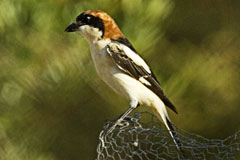 Woodchatshrike |
Beside the above specialised areas, throughout Corfu Swallows, Swifts, Gulls, Oriole, Sparrows, Magpies, Jays, Shrike and most of the common European birds are regularly seen. Local folklore prevents the Greeks from disturbing swallows nests, for fear of developing freckles ! or as in some areas, the fear of a death in the household. So if there are nests on an establishment there will always be a strategically placed piece of cardboard or wood beneath to catch any stray debris but the nest will remain undisturbed. |
 Barn owl |
At night most often heard but not seen is
the Scops Owl who once the sun sets can be heard no matter
where you are on the island, this is a small owl about
8inches long and its call is a single penetrating “PIUWW”.
In recent years this bird has become rather famous as
“Pigwidgeon” the owl in the Harry Potter books. The Scops
owl is known by the Greeks as " gionis “, a Greek
pronunciation of the sound of its call. It is a migratory
bird, some from regions of Africa where it is unfortunately regarded by some as a lucky charm. Here it is trapped, killed and sold to satisfy the superstitious whims of mankind. |
 One euro coin |
The Barn owl
is often heard as it hunts at night with its wheezy cry and
sometimes a frightening shriek. Corfu is near the southern
range of the barn owl in Europe. The Little Owl (Athene Nocturna), known by
the Greeks as Koukouvaya because of its call was very
important in Athenian culture to such an extent that it
appeared on their coinage. The modern Greek One Euro depicts
a copy of one side of this ancient coin.
|
| Download PDF version of this website with more photographs etc. in the downloads section. | |









